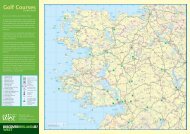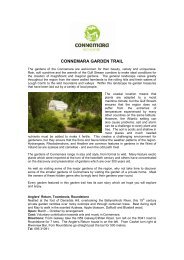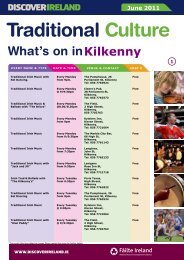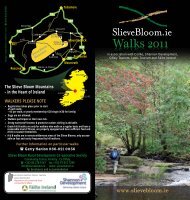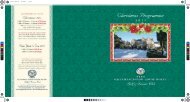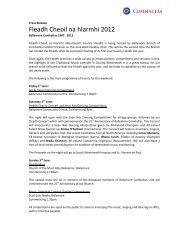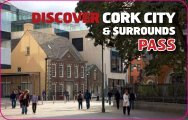Boyne Valley brochure [pdf, 8.03MB] - Discover Ireland
Boyne Valley brochure [pdf, 8.03MB] - Discover Ireland
Boyne Valley brochure [pdf, 8.03MB] - Discover Ireland
Create successful ePaper yourself
Turn your PDF publications into a flip-book with our unique Google optimized e-Paper software.
Trim<br />
Trim contains more Medieval buildings<br />
than any town in <strong>Ireland</strong><br />
Trim is situated on the banks of the River <strong>Boyne</strong> in an area of fertile<br />
plains. The town developed around Trim Castle, straddling the river<br />
to the north and west of the castle. In the 13th century the town was<br />
enclosed within a circuit of stone walls. Augustinian (1202), Franciscan<br />
(1260), and Dominican (1263) friaries were established, indicating<br />
the growing prosperity of the town. In the later medieval period Trim<br />
became an increasingly exposed frontier, standing between the hostile<br />
worlds of the Anglo-Normans and the Gaelic Irish.<br />
Aside from Trim Castle, which dominates<br />
the town, the fragments of the medieval<br />
town are still clearly visible. The wall which<br />
circled the settlement is visible in part, mainly<br />
around Castle St. and Emmet St. west of the<br />
castle. The Sheep Gate is the only surviving of<br />
several medieval gateways to the town. The<br />
jagged Yellow Steeple was formerly a sevenstoried<br />
church tower belonging to St Mary’s<br />
Augustinian Abbey, it gets its name from<br />
the colour of the stonework in the evening<br />
sun. St Patrick’s Church (Church of <strong>Ireland</strong>)<br />
is primarily a 19th century structure, though<br />
with medieval remains.<br />
The tower on its west face incorporates<br />
the arms of Richard, Duke of York, Lord<br />
of Trim and Viceroy in <strong>Ireland</strong> from 1449.<br />
Interestingly, <strong>Ireland</strong>’s oldest complete and<br />
unaltered bridge (dating from 1393) crosses<br />
the <strong>Boyne</strong> at Trim (on Bridge St., Trim).<br />
A few kilometres downstream from Trim<br />
stand the ruins of Newtown Trim – a large<br />
medieval cathedral, two monasteries and a<br />
small church. These ruins symbolise the failed<br />
attempt by the first English Bishop of Meath,<br />
Simon de Rochfort, to establish a rival town to<br />
de Lacy’s Trim.<br />
During the early 1700s Jonathan Swift, author<br />
of Gulliver’s Travels, lived at Laracor, near<br />
Trim, where he served as vicar to a small<br />
congregation. Arthur Wellesley, better known<br />
as the Duke of Wellington or ‘the Iron Duke’,<br />
was educated at Trim and spent much of<br />
his childhood at the nearby Dangan Castle,<br />
his father’s country house (now in ruins). He<br />
is credited with Napoleon’s defeat at the<br />
Battle of Waterloo in 1815, and later served<br />
as Prime Minister of Great Britain (1828-30).<br />
Don Ambrosio O’Higgins (1720 – 1801), the<br />
Spanish Viceroy of Peru and Chile, was born at<br />
Dangan Castle. His son, Bernardo O’Higgins,<br />
went on to become the ‘Liberator of Chile’.<br />
The town of Athboy – 17km west of Navan<br />
on the N51 – offers a heritage trail, and<br />
spectacular views across the county from<br />
an Iron Age fort atop the Hill of Ward where,<br />
right up until the 12th Century, the wild,<br />
Pagan festival of ‘Oiche Samhain’ (Halloween<br />
Night ) was celebrated (October 31) with ritual<br />
bonfires to herald the arrival of Winter. It is<br />
believed that Halloween began here at the Hill<br />
of Ward. This is celebrated annually through<br />
the Halloween Spirits of Meath Festival.<br />
Housed in the Old Town Hall building<br />
Trim Visitor Centre has an audio visual<br />
presentation titled “The Power & the Glory”.<br />
Here visitors can learn more about life in<br />
medieval Trim and County Meath as well as<br />
more about how the coming of the Normans<br />
affected the area. The visitor centre also<br />
has a tourist information point, gift and<br />
coffee shop.<br />
Did you know? There is a small Gaeltacht (Irishspeaking<br />
community) at Ráth Cairn (Rathcarne),<br />
near Trim. In the 1930s a total of 443 people<br />
from Connemara in the west of <strong>Ireland</strong><br />
were resettled on land acquired by the Land<br />
Commission. It received official recognition as a<br />
Gaeltacht in 1967.<br />
In Trim town you can walk along the River <strong>Boyne</strong><br />
and see the ruins of St. Peter & Paul Cathedral<br />
and the Hospital of St John The Baptist. Visitors<br />
can call into the Visitor Centre for a town map<br />
and more details about the walk.<br />
Contact Details:<br />
Trim Visitor Centre and Ramparts Coffee Shop,<br />
Castle St, Trim, Co. Meath<br />
T: +353 (0)46 9437227<br />
F: +353 (0)46 9438053<br />
E: trimvisitorcenter@eircom.net<br />
W: www.meathtourism.ie<br />
GPS: 53.554778 , -6.789759<br />
8 FOR MORE INFORMATION GO TO WWW.BOYNEVALLEYDRIVE.IE FOR OPENING TIMES AND ADMISSION DETAILS PLEASE SEE PULL OUT INSERT AT THE BACK 9


![Boyne Valley brochure [pdf, 8.03MB] - Discover Ireland](https://img.yumpu.com/13306944/10/500x640/boyne-valley-brochure-pdf-803mb-discover-ireland.jpg)




